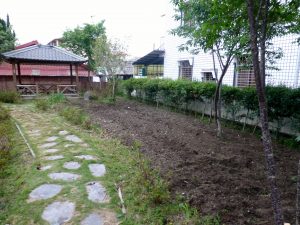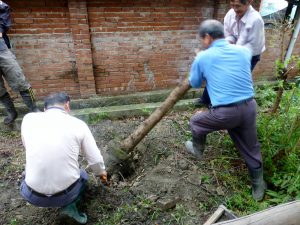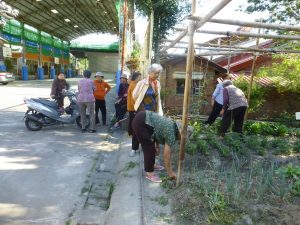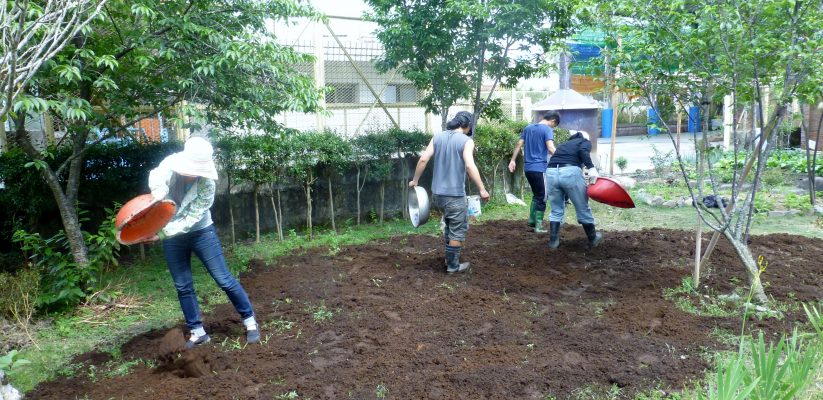Written by Shaw-wu Jung
In an interesting article, Boeck (1998) explores how in building ecological space local people make sense of their material, symbolic, and metaphoric worlds. To put his insights in a context in which a successful reconstruction of a community garden in Lancheng, a small village literally at the centre of Puli township, Nantou County in Taiwan, brings forth a sensitivity to its environment, I will examine how vegetables, as part of the environment seen every day by the residents, are the material world by which abstract cultural elements such as forward-looking environmental consciousness are localised. This case drives us to focus on the embodied activity that tether grand and new ideas such as environmental justice to local sensibility.
From 2013 through 2016, I joined a project at National Chi Nan University in Taiwan. The project built on a community-based, participatory action research method, looking for ways to boost community action. As part of this, I led a team of research assistants and students to Lancheng. Not unlike the majority of rural villages in Taiwan that have experienced outbound migration, especially young people going to the cities looking for jobs, Lancheng has seen an aging population and stagnant economic activities over the past decades.
There is a community park, a 30 m2 piece of land, quite small, located just opposite the activity centre and the community kitchen, a government-sponsored welfare service providing lunch a few times a week for the elderly and those who can’t afford lunch. However, there were no resources to maintain the park to the effect that it had fallen into disuse. The pavement had become disused, and the premises were in poor condition. Gradually, trash had been discarded there and weeds grew everywhere. Snake bites were also occasionally reported. No one regarded the park as safe and relaxing anymore.
After discussing with and getting permission from the secretary-general of Community Development Association, a member-based civic organization, our team decided to renovate the park as part of our collaborative efforts. But first of all, we asked the residents for their opinions about what the park should look like. Among them, the idea of a vegetable garden stood out, where they could both grow vegetables and do exercise. The initial and principal reason for this was that the community kitchen could use the yields from the garden and help reduce financial responsibilities of the Association. Given the fact that since the 1990s, various branches of government have poured resources into the so-call Integrated Community Building policy with the aim of encouraging community involvement, communities have transformed themselves to something like funding competitors which must follow the guidelines of the funders, leaving little room to do what they liked. Financial self-sufficiency was certainly the first step for the community to gain flexibility and control over its own agenda. There was also consensus that the vegetables should be edible and organic, and not grown using industrial pesticides. A vision of this place: ‘a vegetable garden-based park and a park-like vegetable garden’ was brewing (e.g. Follmann and Viehoff 2015).
As soon as the Association and our team reached an agreement that converted the park to a community farming garden, our team and residents jointly began digging soils, removing the bushes, and cutting down the trees behind the gazebo. Within a few days, several parallel beds had been cultivated, with seeds of different vegetables planted. Compared with just talking during the meetings without any real sense of outputs, the activities on the field were swift and efficient, mainly because of the fact that many of the participants had done some sort of farming at some point in their life.

Images of the vegetable garden in initial stages. Image taken by author.
Friendly farming was the approach we used to tend to the garden, even though there was no consensus on what it really meant in practice, let alone the term ‘sustainability’ that friendly farming aims for. Without the use of agrochemicals and synthetic fertilizers, we had to devote considerable labour and time to weeding, for one thing, and needed do it on a daily basis. Students usually weeded particular sections in the morning, but weeds in other areas were removed by others in the afternoon. We had no idea who cleared them. Residents would come to the garden offering us suggestions on how to weed in a more efficient way, and more often than not, brought with them tools to weed. We once saw an elderly woman sitting on a stool removing the weeds on the roadsides by the garden. The weeds on the roadsides were so visible and were seen by residents as a mark of ‘negligence’ and ‘laziness’, or a sign of ‘waste land’, as the old lady put it. Traditional agricultural habits required workers to constantly attend to the land, as if it were an extension of the self. Now it seemed the garden had become something gathering attention in the community through weed’s visible materiality, to use anthropologist Tim Ingold’s phrase (2006), so as to (re)build sociality.

Collaborative work in the vegetable garden. Image taken by author.
The garden produced everything from ginger to pine, mushroom, and many kinds of vegetation that I did not recognise. Then came diverse insects, amphibian, and reptilian species. Frogs and dragonflies were also spotted, which in turn attracted families with children to come close to the garden. We gradually learned that the routine activities passed down from the past generations, such as ploughing, planting, and weeding by manual labour contributed to an ecosystem that supported many species. Old-fashioned farming practices in this tiny garden were perhaps the most ‘natural’ way to manage the land.
The garden started off from the belief that providing free meals for the elderly with the vegetables planted by the residents themselves was self-sustaining in a way. But vegetables were not passive, only waiting for human’s care and intervention. They grew, they connected, with air, soil, and water, and in the end, they transformed from seeds to crops, but they also assembled humans as well as non-human into a lively network. It is important to recognise, however, that the garden was a place where practices of physical exercise, aesthetic judgements, cultural habits, and, of course, state governance intermingled. It began as a state-funded project and it was a place of ideologies, to be sure, but it was a place of other practices too because planting vegetables always took growers outside the predictable world to continuously attune to the possibilities of human and the non-human factors. This echoes recent concerns of anthropologists who have been interested in the ways a novel world of humans and plants support one another to solve many of the environmental problems humans have created under the logic of extracting profit from the exploitation of natural resources (e.g. Hartigan 2015; Ingold 2006; Marder 2013).

Community members working in the vegetable garden. Image taken by author.
Other things happened as plant and people began to interlink. When the most mundane and deserted scenes were made buoyant again, a renewed sense for protecting and maintaining this ecology may have a direct impact upon villagers’ identity. As the old lady said, ‘I tend all of the species, and would pass them on to my children’. While the garden did not start off with the goal of initiating ecological consciousness among residents, in the end, it did show a promising way that ecological resuscitation in a neglected community can be linked with its agricultural past. Here, we saw clearly the importance of taking seriously local sensibilities, traditional agricultural nodes and the bringing together of concrete objects, plants, engaged residents, and communal spirit in the implementation of grand and new environmental ideas.
Shaw-wu Jung is a Taiwan-based anthropologist at Academia Sinica who focuses on law, politics, and the politics of culture. He previously engaged with the intimate spaces of village and local ideas in Taiwan before expanding to the political economy of transnational contexts. To prepare for comparative study, since 2010 he has conducted fieldwork in Hong Kong where a series of related political and legal issues in light of civil society, citizen empowerment, and local culture were explored. Featured image taken by author.
- TV Drama Discourse on Stay-at-home Fathers in China: Super Dad & Super Kids - January 28, 2022
- Freud and China - January 20, 2022
- “Cultural China 2020″—A Different Take on China - January 7, 2022
